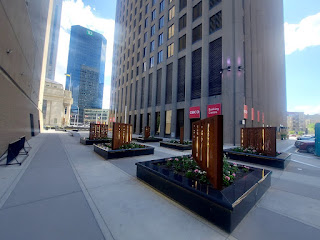Friday, July 4, 2025
Wednesday, July 2, 2025
The Anger of Conservatives in Manitoba
Polling in Manitoba now shows a majority of Conservatives supporting separation. It is a minority position in the overall poll. Some men are so angry and upset that they are all in on western alienation and separation. It is unclear how that translates into a win with a full referendum. It is worth noting that separation parties in the provincial byelections finished third.
There seem to be a lot of conservatives who embrace the 51st state. Certainly there is anger at the election results and in some cases, those that saw their party lost question the electoral system as fixed against them. And by fixed, the suggestion was that Liberals were changing boundaries and stuffing ballots. No amount of evidence could be presented to convince those that believe that. Thankfully, the actual Conservative party didn't make a call to the battlements over losing both the election and the leader's seat. That didn't mean they were happy.
The Liberals are pretty wily. By changing their leader and proroguing Parliament, they changed the calculus. But some of these tactic the Conservatives had done themselves with success. It think what caught Conservatives by surprise is how fast Liberals changes policy platform. Despite calling it cynical and a lie, it ignores how the Liberals have always had right and left components within the party. It is that right that is in power now.
Men are more likely to be separatist than women. And Alberta and Saskatchewan are more likely to have separatist segments of the population than B.C. or Manitoba. In Manitoba it is likely a rural male who thinks on the line of separation. This closely resembles the rest of the west. Those in the city, especially women, are more likely to be in support of a united Canada.
Polls are often snapshots looking backwards. Many conservatives are still stinging from Trudeau and are still stunned the Liberals won with Carney. The popularity if the Liberals and Carney have steadily risen. Even now though some conservatives are mad about Covid, vaccines, the electoral process on a host of issues social and economic. It is unlikely that some on the right will ever forgive the emergency measures. But then again, there is little sympathy from a lot of Canadians who regarded the convoys as being a threat to health and safety.
Carney appears to be managing the premiers fairly well by being open to projects of national importance. Still, Alberta's default position is to criticize the federal government often as a cover for their own performance. Trudeau authorized a full government pipeline that brought more money into Alberta than before and got no credit for it. Harper had no success getting the pipeline through.
Ontario has 15 million people living in the province. Even with the entire western Canada population included, it is smaller than Ontario. For would be separatists it should be obvious that the population of cities in the west outnumbers all of the rural and northern areas. This is important because a lot of separatists are often saying majority rule is unfair. They don't meant the just eastern Canada but cities over rural areas too.
In Manitoba this often mean rural men are angry at people who live in Winnipeg. Does separation mean separating from Winnipeg? These are legitimate questions. If Canada is divisible, does it not mean provinces are as well? And First Nations can easily say they won't separate. Does that mean the province sends the police in? This easily can lead to a civil war.
As mentioned, this is a snapshot on the past months and the present government is not even a year in. Federal-provincial relations seems to be in a much better place than they were a year ago and nation building projects seem to be a focus. Housing and inflation are also on the priority list. All these things combined are likely to take the steam of the separatist agenda. As this most recent Canada Day has show, the Canadian flag has been reclaimed by those who want a unified Canada. The majority does not want to break up the country.
Saturday, June 28, 2025
Changes to the Bus Routes 2025
Some bus routes that have been around for decades end on Sunday. Some in River Heights are mourning the loss of one of on Grosvenor and some in Charleswood are grieving some of theirs. There are few neighbourhoods without some big changes coming. The only one with no real changes is Bridgwater as they underwent the change in 2020. Many people will have to get use to transfers in other parts of the city as well as longer walks.
Winnipeg Transit will have guides out Monday but it will still come as a shock for some that the bus doesn't come down their street anymore. Or that the bus stop on their streets are far away. Literally a thousand bus stops have closed. Some people moved to certain areas because of bus routes so to have one disappear must be depressing.
One major change is that Graham Avenue will no longer be a bus corridor. The goal is to change the street to pedestrian and bike path but how fast this occurs will be important. If on Monday, the buses just stop coming down that way and people leave, it could end up being degraded and a security threat. Worst case scenario is seeing businesses close if they don't get something in place right away. Or for arsons to take any empty buildings there as we have seen on Main Street.
There is a lot of building that will be coming on stream downtown in 2026 so how Winnipeg Transit works with this will be important. It shouldn't for forgotten how the industrial parks, residential areas and hospitals are served as well. Expect their to be some confusion and possibly complaints. And if security for those waiting at transfers isn't addressed, it could downright ugly.
Thursday, June 26, 2025
Applebee's and IHOP Combine on Regent
Monday, June 23, 2025
The Return of Arby's 2025
The restaurant has been open three months now at Season Tuxedo and show no sign of slowing down. Spokesmen for Arby's suggested there were more locations coming. There are still holes to fill along major commercial streets in Winnipeg and around malls. Polo Park comes to mind. Around Kildonan as well.
We'll never see a Hardee's in Canada because the courts have ruled it is too close to Harvey's in name. Hardee's is a competitor in the roast beef sandwiches for Arby's but will never come to the country so long as Harvey's exists. There are a few roast beef places such as Carl Jr's across the land, the nearest being in Regina, but for the time being Arby's it is.
It is hard to find any oxygen when McDonald's has 41 locations alone in Winnipeg. By comparison, there are 14 Burger King's in Winnipeg. If it is any consolation Toronto only has 13. Either way you slice it, it makes for a lot of burger joint. It could be one of the most common foods at restaurants. And yes, that is over chicken and pizza places as well.
It is very likely we will be seeing more diverse restaurants and drive-thrus coming. Certainly there will more Arby's coming to Winnipeg.
Saturday, June 21, 2025
Portage and Main Re-Opening
The Trizec project of the city demolishing and putting up a massive parkade in support of a private 32 story tower changed everything. The city, cognizant of other cities like Montreal, Toronto and Minneapolis believed that skywalks and underground pathways were the favoured choice for cold weather cities. Some resented being forced downstairs to get across but there was wide acceptance of the development as it also came with a mall in Winnipeg Square.
The plebiscite on re-opening Portage and Main was defeated 2-1 in 2018. However, the issues of what to do about the crumbling infrastructure was never really addressed. For many it seemed like there was no need to do anything despite the fact that water had been leaking for sometime. Eventually, a report came out that fixing the Concourse was likely to be in the $70 Plus millions and involve road closures that could be lengthy.Monday, June 16, 2025
Bisons of Roblin Boulevard
I had to watch for traffic as many drivers were distracted and I was pretty much on the curb.Off in the distance the start of the bisons at Assiniboine Park gates.It is possible to see all 26 bison up close but it may be a longer walk for some kids. And as mentioned is not exactly set up for strollers.Assiniboine Park has a fair amount of art in it which is good. The Leo Mol sculpture garden is amazing. From time to time there can be controversy. Case in point is Queen Victoria being toppled and decapitated. There may have been a case to remove it but it is never good to vandalize art.I'm unsure how long the bisons will be out. There are still a few polar bears around from 2005.
Sunday, June 15, 2025
New Charleswood Sign
Charleswood has been experiencing some building south near Ridgewood and some more density along some of its major roads. However, the suburb continues to be one of ditches and roads resembling a small town that what might be seen in some other areas of the city.























.jpg)



.jpg)
























.jpg)